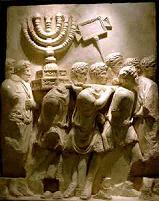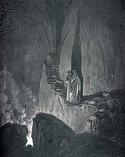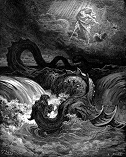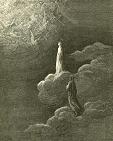The Great Persecution under Caiaphas, Pilate, and Paul
Introduction
The book of revelation depicts two persecutions against the church: the persecution of the dragon and the persecution under the beast, harlot, and false prophet. In this article, we want to identify the time and circumstance of the first of these two great persecutions.
The Dragon, the Woman, and the
Man-child
The
persecution under the dragon is portrayed in Revelation twelve where
it attempts to destroy the man-child at the time of its very birth:
And there
appeared a great wonder in heaven; a woman clothed with the sun, and
the moon under her feet, and upon her head a crown of twelve stars.
And she being with child cried, travailing in birth, and pained to
be delivered.
And there
appeared another wonder in heaven; and behold a great red dragon,
having seven heads and ten horns, and seven crowns upon his heads.
And his tail drew the third part of the stars of heaven, and did
cast them to the earth: and the dragon stood before the woman which
was ready to be delivered, for to devour her child as soon as it was
born.
And she
brought forth a man child, who was to rule all nations with a rod of
iron: and her child was caught up unto God, and to his throne.
And the woman fled into the wilderness, where she hath a place
prepared of God, that they should feed her there a thousand two
hundred and threescore days. Rev. 12:1-6
The basic
imagery is taken from the garden where the dragon appears in the
form of the serpent, which tempted the woman. The serpent was
not a demonic being; it was a serpent, just as the text says.
It was chosen as the medium by which the woman was tempted because
of the symbolic value associated with the venom of its bite. Just as
the bite of the serpent produces physical death, so sin produces
moral, spiritual, and eternal death. From an actual serpent
that was given man’s voice to tempt the woman, the serpent is thence
abstracted and made a symbol for sin and death and those that act in
obedience to their command; the woman a symbol for the people of
God. The scripture’s then foretell the conflict between
offspring of the woman and the serpent:
And the
Lord God said unto the serpent, Because thou hast done this, thou
art cursed above all cattle, and above every beast of the field;
upon thy belly shalt thou go, and dust shalt thou eat all the days
of thy life: and I will put enmity between thee and the woman, and
between thy seed and her seed; it shall bruise thy head, and thou
shalt bruise his heel. Unto the woman he said, I will greatly
multiply thy sorrow and thy conception; in sorrow thou shalt bring
forth children; and thy desire shall be to thy husband, and he shall
rule over thee. Gen. 3:14-16
The woman’s
Seed is Christ; the promised Kinsman Redeemer; the serpent would
“bruise the heel” of the promised Seed (strike a nonfatal blow) in
the crucifixion, but the Seed would crush the serpent’s head by the
power of his cross and resurrection. (Cf. Col. 2:14,
15) The enmity between the woman and the serpent is manifested
in the struggle between the people of God and their worldly
oppressors. The symbol of the serpent was appropriated upon by the
prophets, where it was merged into the symbol of Leviathan, the
world civil power opposing God and oppressing his people:
In that
day the Lord with his sore and great and strong sword shall punish
Leviathan the piercing serpent, even leviathan that crooked serpent;
and he shall slay the dragon that is in the sea. Isa. 27:1
In the Old
Testament, Leviathan most often stood for
Ask of me
and I shall give thee the heathen for thine inheritance, and the
uttermost parts of the earth for thy possession. Thou shalt
break them with a rod of iron; thou shalt dash them to pieces like a
potter’s vessel. Ps. 2:8, 9
The dragon’s
attempt to devour the Christ-child at his birth refers to Herod’s
slaughter of the Innocents. (Matt. 2:16-18) Catching up
of the man child to the God and his throne is prospective, and looks
to the ascension of Christ following his death and resurrection.
Christ’s earthly ministry is depicted in the imagery of Michael and
his angels (Christ and the apostles) doing battle with the dragon
and his angels (Sin,
And they
overcame him by the blood of the Lamb, and by the word of their
testimony; and they loved not their lives unto the death. Rev.
12:11
When the
dragon saw that he was defeated, he turned his wrath upon the woman,
pouring out persecution from its mouth like a flood. (vv.
13-15) This persecution, following as it does fast upon
the heels of the man-child’s ascension, is readily identified with
the persecution that arose over St. Stephen. Stephen was
arraigned before the Sanhedrin on charges of blasphemy for teaching
that Christ would come and destroy the city and temple and change
the customs delivered by Moses. (Acts
The
narrative relates that the woman was given wings for flight and a
place to hide in the wilderness, where she was sustained for a time,
times, and half a time, or one thousand two hundred three score
days. (vv.6, 14) This refers to the scattering of
the church upon the persecution. Driven from
As for Saul,
he made havock of the church, entering into every house, and haling
men and women committed them to prison. Therefore they that
were scattered abroad went every where preaching the word. Acts 8:4;
cf.
Not content
to persecute the church in
I stand
at Caesar’s judgment seat, where I ought to be judged: to the Jews
have I done no wrong, as thou very well knowest. For if I be
an offender, or have committed any thing worthy of death, I refuse
not to die: but if there be none of these things whereof these
accuse me, no man may deliver me unto them. I appeal unto
Caesar. Acts 25:10, 11
This facet
of Roman law, which recognized jurisdiction based upon citizenship,
lay behind Saul’s ability to travel to foreign cities and there
arrest Jews professing faith in Christ. For it had been a
right granted the Jews from the time of Julius Caesar that they were
allowed to keep their own laws, were exempt from military duty and
certain taxes, recognition of the Sabbath day, the right of living
according to the customs of their forefathers, and full jurisdiction
over their own members.
Josephus records numerous edicts by the Romans on behalf of the
nation, securing them various privileges and immunities. One in
particular testifies to the fact that Jews were allowed legislative
bodies and courts in foreign cities with power to make decrees and
adjudicate cases binding their members.
Lucius
Antonius, the son of Marcus, vice-quaestor, and vice-praetor, to the
magistrates, senate, and people of the Sardians, sendeth greeting.
Those Jews that are our fellow-citizens of
The Sceptre of Judah and the ius
gladii
Notwithstanding the ability to arrest Jewish citizens and bring them
to
For
rulers are not a terror to good works, but to the evil. Wilt thou
then not be afraid of the power? Do that which is good, and thou
shalt have praise of the same: for he is the minister of God to thee
for good. But if thou do that which is evil, be afraid; for he
beareth not the sword in vain: for he is the minister of God, a
revenger to execute wrath upon him that doeth evil.”
The ius
gladdii was part of the sceptre of
The
sceptre shall not depart from
The
sovereign power embodied in the sceptre, including the right to
adjudicate and execute capital crimes, was made sure to
And now
Archelaus’s part of
The Persecution Collapses
At length,
Pontius Pilate succeeded to the office of procurator by the
appointment of Tiberius.[5]
The book of Acts is silent about Pilate’s role in the persecution
that arose over Stephen, but, as no one might be put to death in
At the same
time he removed Pilate, Vitellius traveled to
Woe is me because of the house of
Beothus,
Woe is me because of their
staves.
Woe is me because of the house of
Hanan,
Woe is me because of their
whisperings.
Woe is me because of the house of
Kathros,
Woe is me because of their pens.
Woe is me because of the house of
Ismael ben Phabi,
Woe is me because of their fists.
For they are high priests, and
their sons are treasurers, and their sons-in-laws are temple
overseers, and their servants beat the people with clubs.[9]
Restoring
the care and custody of the high priestly garments to the Jews at
the same time he removed Caiaphas indicates that issues concerning
the high priesthood were of high priority to the Jews and that there
was widespread dissatisfaction with Caiaphas. Upon the death
of Festus, before Albinus arrived to replace him, Ananus, the son of
Annas the father-in-law of Caiaphas, convened the Sanhedrin and put
to death James, the Lord’s brother, with several of his fellow
disciples. Josephus records that many of the leading Jews
complained to Albinus of Ananus’ convening of the Sanhedrin and
unlawful usurpation of the ius gladii:
Festus
was now dead, and Albinus was but upon the road; so he [Ananus]
assembled the Sanhedrim of the judges, and brought before them the
brother of Jesus, who was called Christ, whose name was James, and
some others, [or some of his companions;] and when he had formed an
accusation against them as breakers of the law, he delivered them to
be stoned: but as for those who seemed the most equitable of the
citizens, and such as were the most uneasy at the breach of the
laws, they disliked what was done; they also sent to the king
[Agrippa,] desiring him to send to Ananus that he should act so no
more, for that what he had already done was not to be justified:
nay, some of them went also to meet Albinus, as he was upon his
journey from Alexandria, and informed him that it was not lawful for
Ananus to assemble a Sanhedrim without his consent: whereupon
Albinus complied with what they said, and wrote in anger to Ananus,
and threatened that he would bring him to punishment for what he had
done; on which king Agrippa took the high priesthood from him, when
he had ruled but three months, and made Jesus, the son of Damneus,
high priest.[10]
Given that
the apostles and church were held in high esteem by the Jewish
people at the time Caiaphas was removed (Acts 5:12-16) and that many
of the priests were obedient to the faith (Acts 6:7), it is quite
possible that the persecution of the church contributed to the
request Caiaphas be removed from office, much as it did thirty years
later when Ananias was removed by Agrippa II for having stoned
James.
Undaunted by
the loss of the ius gladii in the person of Pilate, Saul
would go on to press the persecution to foreign cities, seeking
letters from the high priests to imprison those calling upon Christ.
However, Saul would never reach
The had
the churches rest throughout all Judaea and Galilee and Samaria, and
were edified; waling in the fear of the Lord, and in the comfort of
the Holy Ghost, were multiplied. (Acts
Agrippa I
would slay James, the brother of John, with the sword, but his
persecution ended almost as abruptly as it started by Agrippa’s
untimely death. (Acts 12) Agrippa II was too young to
manage his father’s kingdom, so Claudius returned
Revelation
indicates the persecution under Caiaphas, Pilate, and Paul lasted
three and a half years. Beginning with the death of Stephen
until the conversion of Paul is three and a half years. Paul
states that he went up to Jerusalem three years after his
conversion; then, he went again fourteen years later to the
Jerusalem Counsel to settle the question whether Gentiles needed to
be circumcised and obey the law of Moses. (Gal. 2:1; Acts
15:2) Most authorities place this at A.D. 50. He
returned two or three years later, while Gallio was proconsul of
Achaia. (Acts
Conclusion
Revelation
twelve depicts the birth of the Savior, his earthly ministry, and
the persecution that erupted over the martyrdom of Stephen. The
wisdom and foresight of God removed the ius gladii from the
tribe of
[1]
Josephus, Antiquities, XVI, x, 17, Whiston ed;
.
Schurer, History of the Jewish People in N.T. Times,
2nd Div, Vol. 2, pp. 234, 259, 264. See Also Suetonius,
Caesar, 42
[4] Ibid, II, viii, 1; Whiston ed.
[5]
The succession of
procurators until the revolt in AD 66: Coponius (6-9AD);
Marcus Ambivius (9-12 AD); Antonius Rufus (12 -15 AD);
Valerius Gratus (15-26 AD); Pontius Pilate (26-36 AD);
Marcelius (36-37 AD); Marullus (37-40 AD); Fadus (44-46 AD);
Tiberius Alexander (46-48 AD); Ventidius Cumanus (48-52 AD);
Felix (52-60); Festus (60-62 AD); Albinus (62-64 AD);
Gessius Florus (64-66 AD). Agrippa I was king from
40-44 AD.
[6] Josephus, Antiquities, XVIII, vi, 2.
[7]
Paul’s testimony that he
was stoned of the Jews resulted from mob action, not lawful
exercise of the ius gladii. (Acts
[8]
Josephus,
Antiquities, XVIII, vi, 3.
[9] B. Pesahim 57a; T. Menahoth 13:21. The house of Kathros has been unearthed by archaeologists and is known as the “burnt house.”
[10]
Josephus, Antiquities,
XX, ix, 1; Whiston ed.
To receive Kurt Simmons’ e-mail newsletter, The Sword & The Plow, click the Subscribe link:
All rights reserved.






